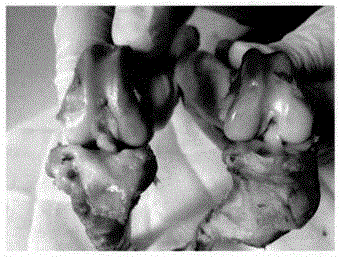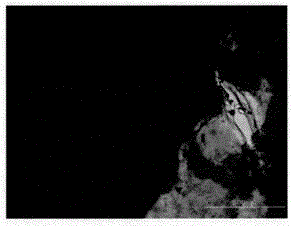Porous cross pin for operational internal fixation of anterior cruciate ligament for tissue engineering
A body and alloy technology, which is applied in the field of biomedical devices and devices for the treatment of anterior cruciate ligament reconstruction, can solve the problems of not promoting tendon-bone healing, interfering with tendon-bone interface healing, and polylactic acid having no osteoinductive properties, achieving the best results. Therapeutic effect, the promotion of tendon and bone healing, the effect of sustained release of cytokines
- Summary
- Abstract
- Description
- Claims
- Application Information
AI Technical Summary
Problems solved by technology
Method used
Image
Examples
Embodiment 1
[0067] Embodiment 1: as Figure 5 As shown, the adopted specification is Φ2mm*12mm, the range of the two porous areas is: 1mm-3mm, the porosity is 50%-70%, the pore diameter is 1-50μm, and biological factors such as BMP-2, BMSC, and FGF are compounded in the porous area. The surface coating is Ca-P, micro-arc oxidation coating, fluoride coating, alkali heat treatment coating, thermal organic film, phosphating film, hydroxyapatite layer of porous transversal nails. Performed femoral tendon fixation for ACL reconstruction in a beagle dog. On the 4th day, 4th week, 8th week, and 12th week after ACL reconstruction, beagle dogs were anesthetized intravenously with pentobarbital sodium (30 mg / kg), and CT examination was performed to dynamically observe the implanted porous ZK60 magnesium alloy The degradation of the Rigid-fix nail in the body and the surrounding bone formation. At the same time, for the CT results at different time points, the CT display field of view (DisplayField...
Embodiment 2
[0072] The specification is Φ3mm*30mm, the range of the two porous areas is: 3mm-5mm, the porosity is 50%-70%, the pore size is 1-50μm, and the biological factors such as BMP-2, BMSC, FGF are compounded in the porous area, and the surface coating It is a porous transversal nail for Ca-P, micro-arc oxidation coating, fluoride coating, alkali heat treatment coating, thermal organic film, phosphating film, and hydroxyapatite layer. Performed femoral tendon fixation for ACL reconstruction in a beagle dog.
[0073] Twelve weeks after the operation, after intravenous anesthesia with sodium pentobarbital (30 mg / kg), 10 ml of potassium chloride was administered intravenously, the animals were sacrificed, and the knee joints were dissected to obtain specimens. The general appearance of the specimen showed that the anterior cruciate ligament of the knee joint was in place and continuous after transplantation, and the tissue of the original tibial stump had gradually crawled and grown to...
Embodiment 3
[0078] The specification is Φ3.3mm*25mm, the range of the two porous areas is: 1mm-3mm, the porosity is 50%-70%, the pore diameter is 1-50μm, and biological factors such as BMP-2, BMSC, and FGF are compounded in the porous area. The coating is Ca-P, micro-arc oxidation coating, fluoride coating, alkali heat treatment coating, thermal organic film, phosphating film, hydroxyapatite layer of porous transversal nails. Performed femoral tendon fixation for ACL reconstruction in a beagle dog.
[0079] Split the femoral specimen of the knee joint vertically along the top of the pulley, and soak the specimen in 4% formalin solution (PH7.4) according to the standard hard tissue pathology sectioning procedure, and store it in a refrigerator at 4°C for fixation For 48 hours, use different concentrations of alcohol to dehydrate the specimen (70% for 5 days, 75% for 5 days, 80% for 5 days, 90% for 5 days, 95% for 5 days, 100% for 5 days twice, xylene for 5 days and 2 times second), after ...
PUM
 Login to View More
Login to View More Abstract
Description
Claims
Application Information
 Login to View More
Login to View More - R&D
- Intellectual Property
- Life Sciences
- Materials
- Tech Scout
- Unparalleled Data Quality
- Higher Quality Content
- 60% Fewer Hallucinations
Browse by: Latest US Patents, China's latest patents, Technical Efficacy Thesaurus, Application Domain, Technology Topic, Popular Technical Reports.
© 2025 PatSnap. All rights reserved.Legal|Privacy policy|Modern Slavery Act Transparency Statement|Sitemap|About US| Contact US: help@patsnap.com



